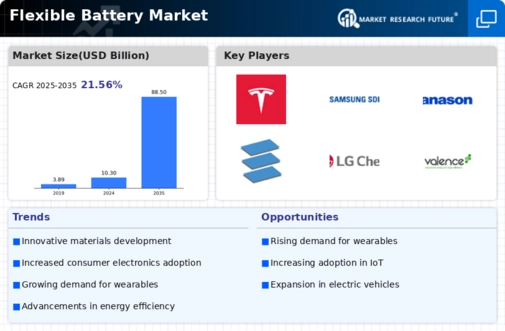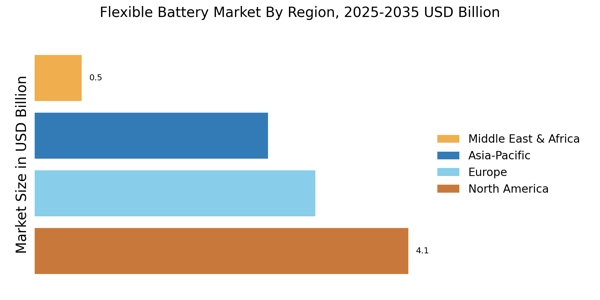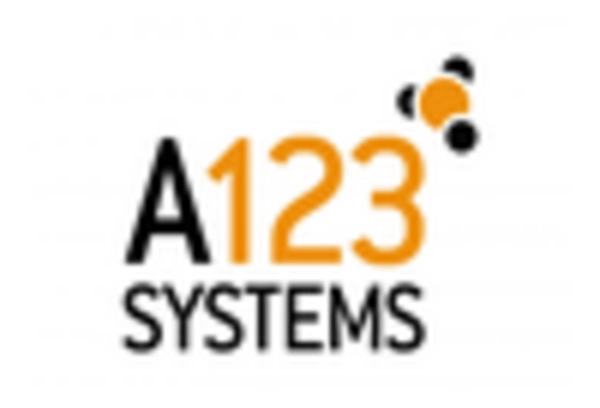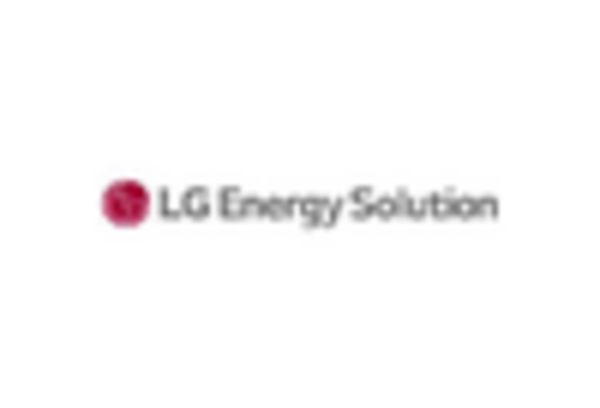Emergence of Smart Textiles
The emergence of smart textiles is driving innovation within the Flexible Battery Market. As the fashion and technology sectors converge, there is a growing demand for textiles that can integrate electronic components, including flexible batteries. These smart textiles can be used in various applications, such as health monitoring and fitness tracking, where lightweight and flexible power sources are essential. Market Research Future suggests that the smart textiles market is projected to grow significantly, potentially reaching billions in revenue by the end of the decade. This trend indicates that the Flexible Battery Market will likely see increased collaboration between textile manufacturers and battery developers to create innovative solutions that meet the needs of this evolving market.
Growth in Electric Vehicle Adoption
The surge in electric vehicle (EV) adoption is a significant driver for the Flexible Battery Market. As governments and consumers prioritize sustainable transportation, the demand for advanced battery technologies is escalating. Flexible batteries, with their potential for lightweight and high-performance applications, are being explored for use in EVs. Recent statistics indicate that the electric vehicle market is expected to witness a compound annual growth rate of over 20% in the next decade. This growth is likely to create opportunities for flexible battery manufacturers to develop innovative solutions tailored for the automotive sector. Consequently, the Flexible Battery Market stands to gain from the increasing integration of flexible battery technologies in electric vehicles.
Rising Demand for Portable Electronics
The increasing demand for portable electronics is a primary driver of the Flexible Battery Market. As consumers seek lightweight and compact devices, manufacturers are compelled to innovate. Flexible batteries, with their lightweight and adaptable nature, are well-suited for smartphones, tablets, and other portable gadgets. According to recent data, the portable electronics segment is projected to grow at a compound annual growth rate of over 10% in the coming years. This growth is likely to stimulate further advancements in flexible battery technology, enhancing energy density and reducing charging times. Consequently, the Flexible Battery Market is expected to expand significantly as manufacturers respond to consumer preferences for more efficient and versatile power solutions.
Advancements in Renewable Energy Solutions
The shift towards renewable energy sources is influencing the Flexible Battery Market. As the world increasingly embraces solar and wind energy, the need for efficient energy storage solutions becomes paramount. Flexible batteries offer a promising alternative for storing energy generated from renewable sources due to their lightweight and flexible design. This adaptability allows for integration into various applications, including solar panels and portable energy storage systems. Market data indicates that the renewable energy sector is anticipated to grow substantially, with energy storage solutions projected to reach a market size of several billion dollars by 2030. This trend suggests that the Flexible Battery Market will likely benefit from the rising demand for sustainable energy storage options.
Increased Investment in Research and Development
Increased investment in research and development (R&D) is a crucial driver for the Flexible Battery Market. As companies recognize the potential of flexible batteries, they are allocating more resources to innovate and enhance battery performance. This investment is likely to lead to breakthroughs in energy density, charging speed, and overall efficiency. Recent data indicates that R&D spending in the battery sector is expected to rise significantly, with many companies focusing on developing next-generation flexible batteries. This trend suggests that the Flexible Battery Market will benefit from enhanced product offerings and improved technologies, ultimately leading to greater market penetration and consumer adoption.


















Leave a Comment